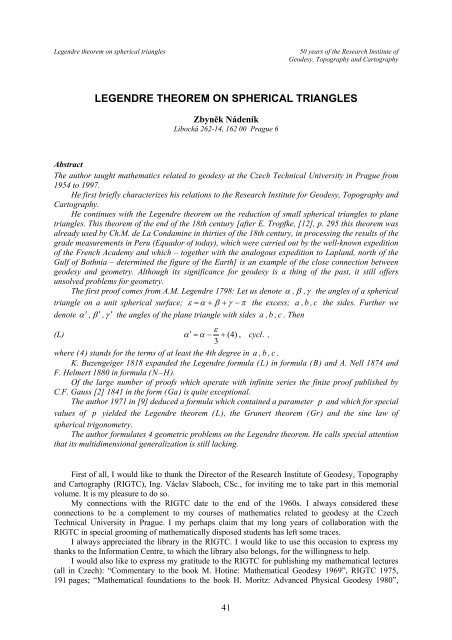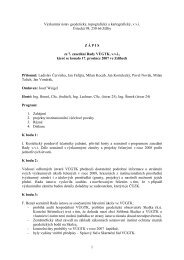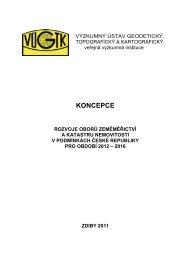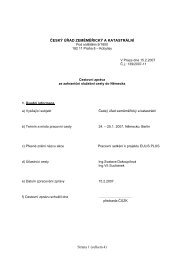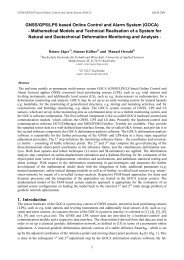LEGENDRE THEOREM ON SPHERICAL TRIANGLES
LEGENDRE THEOREM ON SPHERICAL TRIANGLES
LEGENDRE THEOREM ON SPHERICAL TRIANGLES
Create successful ePaper yourself
Turn your PDF publications into a flip-book with our unique Google optimized e-Paper software.
Legendre theorem on spherical triangles50 years of the Research Institute ofGeodesy, Topography and Cartography<strong>LEGENDRE</strong> <strong>THEOREM</strong> <strong>ON</strong> <strong>SPHERICAL</strong> <strong>TRIANGLES</strong>Zbyněk NádeníkLibocká 262-14, 162 00 Prague 6AbstractThe author taught mathematics related to geodesy at the Czech Technical University in Prague from1954 to 1997.He first briefly characterizes his relations to the Research Institute for Geodesy, Topography andCartography.He continues with the Legendre theorem on the reduction of small spherical triangles to planetriangles. This theorem of the end of the 18th century [after E. Tropfke, [12], p. 295 this theorem wasalready used by Ch.M. de La Condamine in thirties of the 18th century, in processing the results of thegrade measurements in Peru (Equador of today), which were carried out by the well-known expeditionof the French Academy and which – together with the analogous expedition to Lapland, north of theGulf of Bothnia – determined the figure of the Earth] is an example of the close connection betweengeodesy and geometry. Although its significance for geodesy is a thing of the past, it still offersunsolved problems for geometry.The first proof comes from A.M. Legendre 1798: Let us denote α , β ,γ the angles of a sphericaltriangle on a unit spherical surface; ε = α + β + γ − π the excess; a , b , c the sides. Further wedenote α ′ , β ′ ,γ ′ the angles of the plane triangle with sides a , b , c . Thenε(L) α′ = α − + (4) , cycl.,3where (4) stands for the terms of at least the 4th degree in a , b , c .K. Buzengeiger 1818 expanded the Legendre formula (L) in formula (B) and A. Nell 1874 andF. Helmert 1880 in formula (N–H).Of the large number of proofs which operate with infinite series the finite proof published byC.F. Gauss [2] 1841 in the form (Ga) is quite exceptional.The author 1971 in [9] deduced a formula which contained a parameter p and which for specialvalues of p yielded the Legendre theorem (L), the Grunert theorem (Gr) and the sine law ofspherical trigonometry.The author formulates 4 geometric problems on the Legendre theorem. He calls special attentionthat its multidimensional generalization is still lacking.First of all, I would like to thank the Director of the Research Institute of Geodesy, Topographyand Cartography (RIGTC), Ing. Václav Slaboch, CSc., for inviting me to take part in this memorialvolume. It is my pleasure to do so.My connections with the RIGTC date to the end of the 1960s. I always considered theseconnections to be a complement to my courses of mathematics related to geodesy at the CzechTechnical University in Prague. I my perhaps claim that my long years of collaboration with theRIGTC in special grooming of mathematically disposed students has left some traces.I always appreciated the library in the RIGTC. I would like to use this occasion to express mythanks to the Information Centre, to which the library also belongs, for the willingness to help.I would also like to express my gratitude to the RIGTC for publishing my mathematical lectures(all in Czech): “Commentary to the book M. Hotine: Mathematical Geodesy 1969”, RIGTC 1975,191 pages; “Mathematical foundations to the book H. Moritz: Advanced Physical Geodesy 1980”,41
50 years of the Research Institute of Z. NádeníkGeodesy, Topography and CartographyRICTC 1984, 185 pages; “Spherical harmonics for geodesy – Mathematical grooming to the study ofthe book W. A. Heiskanen – H. Moritz: Physical Geodesy 1967 ”, RIGTC 2000, 129 pages.I also acknowledge with thanks that the RIGTC, together with the Geographic Service of theArmy of the Czech Republic, organized a meeting with colleagues-geodesists at the occasion of myanniversary in December 2000; the text of my speech together with four discussion contributions,were also published by the RIGTC in 2002 (in Czech), 34 pages.Since 1992 I have been a member of Scientific Council of the RIGTC. I may perhaps claim thatalso as its member I tried to improve the scientific training of the young geodetic generation. When Iconcluded, at the age of 70, at the beginning of the second half of the 1990s, the essential part of myactivity, inclusive of membership in the Scientific Council of the RIGTC, I accepted, in May 1997, thehonorary membership in the Scientific Council as a distinction. On the contrary, I wish to mention thatdue to disagreement concerning scientific work I did not accept the gold Felber Medal of theTechnical University in Prague in 1986, and in 1996 the candidature for honorary membership in theUnion of Czech Mathematicians and Physicists.I wish the RIGTC at the occasion of its 50th anniversary successful continuation of all its goodtraditions as a research and scientific centre for the prosperity of the whole Czech geodeticcommunity.I.The following text concerns the Legendre theorem on reducing the spherical triangle to the planetriangle. It has been written exclusively from the geometric point of view, and in no way encroacheson the significance of the Legendre theorem for geodesy. It is well known that this significance wasenormous at the end of the 18th century and in the first half of the 19th century, when the Legendretheorem enabled the calculation of large geodetic networks, on the basis of which F.W. Bessel 1841calculated the dimensions of the Earth.The history of the Legendre theorem was presented by F. Hauer [4] 1938. J. Tropfke [12] 1903(see part VI: Die Sphärik und sphärische Trigonometrie, especially p. 295) indicated that the theoremhad already been used by Ch.M. de La Condamine 1740 in processing the results of the well-knownexpedition organized by the French Academy for the purpose of grade measurements in Peru.I lectured at geometric conferences in Austria in 1994 and in Germany in 2002 on the Legendretheorem conceived as a geometric theorem of spherical trigonometry.Let us consider Euler’s spherical triangle with vertices A , B , C , with sides a , b , c , with anglesα , β ,γ (in the usual notation) and with the excess ε = α + β + γ − π on the unite sphere ( R = 1).The angles of plane triangle ABC ′ ′ ′ with the same sides a , b , c will be denoted α ′ , β ′ ,γ ′ (also inthe usual notation).Adrien-Marie Legendre formulated in 1787 [6] and proved in 1798 [7], thatε(L) α′ = α − + (4) , cycl.3The symbol ( n ) stands for the terms in a , b , c of degree at least n . In other words: A small sphericaltriangle [i.e. if the fourth and higher powers of sides a , b , c can be neglected with respect to R = 1]can be solved as a plane triangle, the angles of which originate from the angles of the originalspherical triangle by subtracting one third of the excess. [Example: If we put the Earth’s radius of6370 km as R = 1, the number 0, 015… then corresponds to an arc of 100 km in length on the great8circle; its fourth power 10 − ⋅ 6,07 … and higher powers are neglected. ]In view of the sine law for plane triangle ABC ′ ′ ′ – namely (sin α′ ) / a= (sin β′ ) / b= (sin γ′) / c –we can also express the Legendre theorem in the form(L’)sin( α − ε / 3) sin( β − ε / 3) sin( γ − ε / 3)= = ,a b c42
Legendre theorem on spherical triangles50 years of the Research Institute ofGeodesy, Topography and Cartographywhere the symbol means here and in paragraph III equality under neglection of (4) .The Legendre theorem is the most interesting theorem of elementary spherical trigonometry. It isespecially conspicuous that – irrespective of the magnitude of angles α , β ,γ – one third of the excessis always subtracted.Karl Buzengeiger 1818 in [1] expanded the Legendre theorem (L) to(B)ε ε 2 2 2α′ = α − − ( − 2 a + b + c ) + (6); cycl.3 180The cyclically formed expressions of (B)2 2 2 2 2 2 2 2 2− 2 a + b + c , a − 2 b + c , a + b −2care not all positive or all negative. If two of them are null, then also the third is null and a= b= c.A. Nell 1874 in [10] and F. Helmert 1880 [5] (see p. 92-93) expanded Buzengeiger’s resultfurther:ε ε 2 2 2α′ = α − − ( − 2 a + b + c ) −3 180(N–H)ε4 4 4 2 2 2 2 2 2− ( − 38a + 19b + 19c + a b − 2 b c + a c ) + (8); cycl.90720If our spherical triangle is equilateral or equiangular, then a= b= c and formulae (B) and(N–H) reduce toεα′ = α − + (6) ; cycl.3andεα′ = α − + (8) ; cycl.3respectively. This was to be expected, because – irrespective of the magnitude of spherical triangleABC – if a= b= c, then α = β = γ , α′ = β′ = γ′= π /3, so that from α + β + γ = π + ε followsfirstly that 3α = π + ε , i. e.εα = α′ + ; cycl.3In this case the Legendre formula (L) holds exactly. [E.g. the large spherical triangle ABC formed bythe arc of the equator and the arcs of the meridians with longitudes 0 and π /2, has all sides equal toπ /2, all angles are π /2, and the excess is π /2; the corresponding plane triangle ABC ′ ′ ′ is1equilateral and has angles π /3 = π /2 − ( π /2).3From the exact validity of the Legendre theorem for an equilateral spherical triangle ABC of anysize then follows: For an “almost” equilateral spherical triangle, however large, i.e. a , b , c being“nearly” mutually equal, α ′ is “nearly” equal to α − ε / 3; cycl .We thus have this lucid situation: The relations α′ = α − ε /3,cycl. hold for a small, equilateral,almost equilateral spherical triangle ABC approximately, exactly, approximately, respectively.Problem I: To find all spherical triangles for which α′ = α − ε /3,cycl. exactly orapproximately.II.Among many proofs of the Legendre theorem that operate with infinite series, the finite proofgiven by C. Gauss [2] 1841 has a quite exceptional position.The starting point are the known elementary formulae for half the side of the spherical triangle43
50 years of the Research Institute of Z. NádeníkGeodesy, Topography and Cartographywhere2 a cos( σ − β) cos( σ −γ) 2 a cosσ cos( σ −α)cos = , sin = − ,2 sinβ sin γ 2 sinβ sinγα + β + γ π εσ = = + .2 2 2Ifα ∗ = α − ε / 3; cycl. then α ∗ , β ∗ ,γ ∗ are the angles of a plane triangle andHence⎛π ε ⎞ ⎛ * ε ⎞ π ⎛ * ε ⎞σ − α = ⎜ + ⎟− ⎜α + ⎟ = −⎜α− ⎟; cycl.⎝ 2 2⎠ ⎝ 3⎠ 2 ⎝ 6⎠∗2 a sin( β −ε / 6) sin( γ −ε/ 6)cos =; cycl.∗∗2 sin( β + ε / 3)sin( γ + ε / 3)∗2 a sin( ε / 2)sin( α − ε / 6)sin =; cycl.∗∗2 sin( β + ε / 3) sin( γ + ε / 3)a a b bConsequently, simple calculation yields (remember that cos > 0 , sin > 0 , cos > 0 , sin > 0 )2 2 2 23 a 3 bsin sin2 *∗2 2 sin ( α − ε / 6)sin( α + ε / 3): =.a b2 *∗cos cossin ( β − ε / 6)sin( β + ε / 3)2 2This relation may first be altered to readand then to(Ga)a 3 bcos sin2 22 * *1 = ⋅ ⋅sin ( α − ε / 6)sin( α + ε / 3) ⋅2 * *3 a bsin ( / 6)sin( / 3)sin⋅cos2 23 a3 b* a cos 8sina sinα= ⋅2 2*3 ⋅ 3 ⋅b sin β3 a 3 b8sin b cos2 22 * * 3 *sin ( α − ε / 6)sin( α + ε / 3) sin β3 ⋅ 33 * 2 * *This is Gauss form of the Legendre theorem.Indeed, the first 3 in (Ga) is⎡∗1β − ε β + εsin α sin ( β − ε / 6) sin( β + ε / 3)23 a5a ⎢1 − + (4) ⎥3 a8a − + (7)⎣ ⎦ 833 3 = 335 = + = +3 a⎡a a ⎤8 (5) a⎢ − + ⎥⎣2 48 ⎦⎤− + (7)81 (4) 1 (4) ..44
Legendre theorem on spherical triangles50 years of the Research Institute ofGeodesy, Topography and CartographyIn the same way one finds that the second 3 in (Ga) has the form 1 + (4) . – As [remember that the2excess is ε = (4) ]then22 * ⎡ ∗ ε ∗ ⎤ 2 ∗ ε ∗ ∗sin ( α − ε / 6) = ⎢sinα − cos α + (4) = sin α − sinα cos α + (4) ,6 ⎥⎣⎦3* * ε *sin( α + ε / 3) = sinα + cos α + (4) ,32 ∗∗3 *sin ( α − ε / 6) sin( α + ε / 3) sin α + (4)= = 1 + 43 * 3 *sin αsin αand the third 3 in (Ga) has the form 1 + (4) again. Quite analogously the same holds for the fourth3in (Ga). – The product of all roots in (Ga) thus has the form 1 + (4) and Gauss’ expression of theLegendre theorem (L) may be expressed as follows:a sin( α − ε / 3)= ⋅ {1 − (4)}b sin( β − ε / 3)or – using the cyclic changea: b: c= sin( α −ε /3):sin( β −ε /3):sin( γ −ε/3) .If a= b= c, then of course α = β = γ (and vice versa) and in Gauss’ formula (Ga) in this casethe product of the four cube roots equals 1. Problem I is closely connected withProblem II: Determine all spherical triangles for which the product of the four cube roots in theformula (Ga) equals exactly or approximately 1 .III.Let ∆ be the area of plane triangle ABC ′ ′ ′ with sides a , b , c ; let p be a parameter in theneighbourhood of null. In [9] it was proved that⎡ ⎛1⎞ ⎤sin ⎢α− ⎜ + 2 p ⎟ε3⎥23a+ pa + (5) abc⎣ ⎝ ⎠ ⎦ ∆2 2 2(N) = { 1 − p( a + b + c ) + (4)}The fraction on the right-hand side equals the reciprocal diameter 2r of the circle circumscribed abouttriangle ABC ′ ′ ′; let us remind the reader thatsinα′ 1 2∆= = .a 2r abcAs the right-hand side in (N) does not change – with the exception of (4) – with the cyclic change ofsides a , b , c , then – again with the exception of (4) –( ).( N’ )⎡ ⎛1 ⎞ ⎤ ⎡ ⎛1 ⎞ ⎤ ⎡ ⎛1⎞ ⎤sin ⎢α − ⎜ + 2 p⎟ε sin β 2 p ε sin γ 2 p ε3⎥ ⎢ − ⎜ + ⎟3⎥ ⎢ − ⎜ + ⎟3⎥⎣ ⎝ ⎠ ⎦ ⎝ ⎠ ⎝ ⎠=⎣ ⎦ ⎣ ⎦ = ;3 3 3a+ pa + (5) b+ pb + (5) c+ pc + (5)the meaning of the symbol will not be repeated.45
50 years of the Research Institute of Z. NádeníkGeodesy, Topography and CartographyThere immediately appearsProblem III: Is it possible to prove (N) or (N’) in a finite way modelled after Gauss’ proof inPart II?– – –1. For p = 0 formula (N’) reduces to the Legendre theorem in the form of (L’).2. For p =− 1/ 24 formula (N’) reduces tosin( α − ε / 4)= cycl.3aa − + (5)24The length of the chord joining the vertices B and C of our spherical triangle isa aa = 2sin = a− + (5) .2 24Hencesin( α −ε / 4) sin( β −ε / 4) sin( γ −ε/ 4)(Gr)= = .abcThis relation was established by J. Grunert in 1855 [3]. M. Burša called attention to it in [8] 1 , p. 35.3. For p =− 1/ 6 formula (N’) reduces tosinα sin β sin γ ,sin a sin b sin cbecause a− a 3 /6 + (5) sina. We thus arrive at the approximate sine law (of spherical trigonometry)which, of course, holds exactly.– – –That which I describe in the next two cases for side BC of spherical triangle ABC , is consideredalso applied to the other two sides CA and AB .Let a regular polygonal line with n sides be inscribed into side BC . The length of this polygonalline is3a a2nsin = a− + (5) .22n24nIf n = 1 , this polygonal line is reduced to chord BC , if n →∞, it becomes side BC . For2p=− 1/24nformula (N’) has the form⎡ ⎛1 1 ⎞ ⎤sin ⎢α−⎜−2 ⎟ε3⎥⎣ ⎝ 12n⎠ ⎦cycl.3 = aa − + (5)224nThe longitude of our inscribed polygonal line is in the denominator. If n = 1 , we arrive at Grunert’sformula (Gr) and if n →∞ at the Legendre theorem in the form (L’).Let us circumscribe polygonal line PPP 0 1 2… PP n n+1with P 0≡ B, Pn+ 1≡ C about side BC asfollows: 2PP 0 1= PP1 2= … Pn− 1Pn = 2PPn n+1; the segments PP 0 1and PPn n + 1touch side BC at point1 I reviewed this book in Zentralblatt für Mathematik 117 (1965), 177.346
Legendre theorem on spherical triangles50 years of the Research Institute ofGeodesy, Topography and CartographyP0≡ B and Pn+ 1≡ C , respectively; segment PPi i+ 1( i= 1,2, …, n−1)touches side BC at the centre ofBP … P C is thenPPi i + 1. The length of polygonal line1 na a2ntan = a+ + (5) .22n12nIf n = 1 then this polygonal line is reduced to two segments BP1and PC 1, which touch side BC ofthe spherical triangle at points B and C . If n →∞, then our polygonal line becomes side BC of2spherical triangle ABC . For p= 1/12nformula ( N’ ) has the form⎡ ⎛1 1 ⎞ ⎤sin ⎢α− ⎜ +2 ⎟ε3⎥⎣ ⎝ 6n⎠ ⎦cycl.3 = aa + + (5)212nThe longitude of our circumscribed polygonal line is in the denominator. If n →∞, then we arrive atthe Legendre theorem in the form (L’) .VI.In 3-dimensional space the spherical 3-angle on a 2-dimensional spherical surface (sphere) S2isformed by 3 arcs of 3 (1-dimensional) great circles (their planes pass through the centre of thespherical surface S2).In 4-dimensional space the spherical 4-hedron on a 3-dimensional spherical hypersurface(hypersphere) S3is formed by 4 parts of 4 (2-dimensional) great spherical surfaces (their spaces passthrough the centre of the spherical hypersurface S3).This step into 4-dimensional space leads toProblem IV: Does an analogy of the Legendre theorem on the spherical 3-angle (on2-dimensional spherical surface S 2in 3-dimensional space) exist for a spherical 4-hedron (on3-dimensional spherical hypersurface S3in 4-dimensional space)?If we apply a suitable terminology, it is possible to express this problem also in n-dimensionalspace.The well-known fact that the area of a spherical triangle on a unit sphere equals its excess 2 has aclose analogy only in spaces of odd dimension. We can thus conclude that if n-dimensional analogiesto the Legendre theorem exist at all, they differ after the parity of dimension n .B.A. Rozenfel’d [11] 3 1966 deals in Chapter 6 with the geometry of spheres in n-dimensionalspace; for the above-mentioned problem IV see especially §3, p. 244-255.3References[1] Buzengeiger K.: Vergleichung zweier kleiner Dreiecke von gleichen Seiten, wovon das eine sphärisch, dasandere eben ist. Zeitschrift für Astronomie und verwandte Wissenschaften 6 (1818), 264-270.[2] Gauss C.F.: Elementare Ableitung eines zuerst von Legendre aufgestellten Lehrsatzes der sphärischenTrigonometrie. Journal für die reine und angewandte Mathematik 2 (1841), 96.[3] Grunert J.A.: Das sphärische Dreieck, mit seinem Sehnendreieck verglichen, mit besonderer Rücksicht aufGeodäsie. Neuer merkwürdiger Lehrsatz. Archiv der Mathematik und Physik 25 (1855), 196-210.2 Expressed by T. Harriot (1560-1621) 1603 and proved by A. Girard (1592-1632) 1629 by infinitesimalconsideration; the known elementary proof was given by B. Cavalieri (1598-1647) 1632.3 As regards this book, refer to my review in Mathematical Reviews 34 (1967), 6594.47
50 years of the Research Institute of Z. NádeníkGeodesy, Topography and Cartography[4] Hauer F.: Zur Geschichte des Satzes von Legendre. Zeitschrift für Vermessungswesen 67 (1938), 577-595,641-653.[5] Helmert F.: Die mathematischen und physikalischen Teorien der höheren Geodäsie. Vol. I, Leipzig 1880.2nd ed. 1962.[6] Legendre A.M.: Mémoire sur les opérations trigonométriques, dont les résultats dépendent de la figure dela Terre. Histoire de l’Académie royale de sciences, Paris 1787; 352-383.[7] Legendre A.M.: Méthode pour déterminer la longueur exacte du quart du méridien d’après les observationsfaites pour la mesure de l’arc compris entre Dunkerque et Barcelone, Note III: Résolution des trianglessphériques dont des côtés sont très petits par rapport au rayon de la sphère. J.B. Delembre: Méthodesanalytiques pour la détermination d’un arc du méridien, Paris 1798; 12-14.[8] Molodenskiĭ M.S., Eremeev V.F., Yurkina M.I.: Metody izucheniya vneshnego gravitatsionnogo polyai figury Zemli. Moscow 1960 (Молоденский, М.С., Еремеев, В.Ф., Юркина, М.И.: Методы изучениявнешнего гравитационного поля и фигуры Земли. Москва 1960). English transl. Washington 1962.[9] Nádeník Z.: Über Reduktion der sphärischen Dreiecke. Aplikace matematiky 16 (1971), 229-231.[10] Nell A.: Neue Herleitung des Legendreschen Satzes nebst einer Erweiterung desselben. Zeitschrift fürMathematik und Physik 19 (1874), 324-334.[11] Rozenfel’d B.A.: Mnogomernye prostranstva. Moscow 1966 (Розенфельд, Б.А.: Многомерные пространства.Москва 1966).[12] Tropfke J.: Geschichte der Elementar-Mathematik. Vol. II, Leipzig 1903 [in 2 vol.; 2nd ed. 1921-24 in7 vol.; 3rd ed. 1930-40 in 4 vol.; new elaboration of vol. I 1980].AbstraktLegendreova věta pro sférické trojúhelníkyAutor v letech 1954-1997 trvale vyučoval matematiku na geodetickém oboru ČVUT v Praze.Nejdříve stručně charakterizuje své vztahy k Výzkumnému ústavu geodetickému, topografickémua kartografickému.Pak přechází k Legendreově větě o redukci malých sférických trojúhelníků na rovinné. Tato větaz konce 18. stol. [podle E. Tropfke [12] str. 295 s ní pracoval už Ch.M. de La Condamine ve 30. letech18. století při zpracování výsledků stupňového měření v Peru (dnes Equadoru), které podnikla známáexpedice francouzské Akademie a které – spolu s analogickou expedicí do Laponska severně odBotnického zálivu – rozhodlo o tvaru Země] je příkladem úzkého sepětí geodézie s geometrií. I kdyžjejí význam pro geodézii dávno pominul, pro geometrii nabízí dodnes nerozřešené otázky.První důkaz pochází od A.M. Legendrea 1798: Označíme α , β ,γ úhly sférického trojúhelníkana jednotkové kulové ploše; ε = α + β + γ − π exces; a , b , c strany. Dále označíme α ′ , β ′ ,γ ′ úhlyrovinného trojúhelníka se stranami a , b , c . Pakε(L) α′ = α − + (4) , cycl.,3kde (4) znamená členy stupně alespoň 4 v a,b,c.Legendreův vzorec (L) prolongovali K. Buzengeiger 1818 ve vzorec (B) a A. Nell 1874 iF. Helmert 1880 ve vzorec (N–H).Z dlouhé řady důkazů, které pracují s nekonečnými řadami, se zcela vymyká finitní důkaz, kterýuveřejnil C.F. Gauss [2] 1841 ve formě (Ga).Autor 1971 v [9] odvodil formuli (N), která obsahuje parametr p a která pro jeho speciálníhodnoty poskytuje větu Legendreovu (L), větu Grunertovu (Gr) a větu sinovou ze sférickétrigonometrie.Autor formuluje 4 geometrické problémy o Legendreově větě. Zvláště upozorňuje, že zatím chybíjakékoliv její vícedimensionální zobecnění.48


